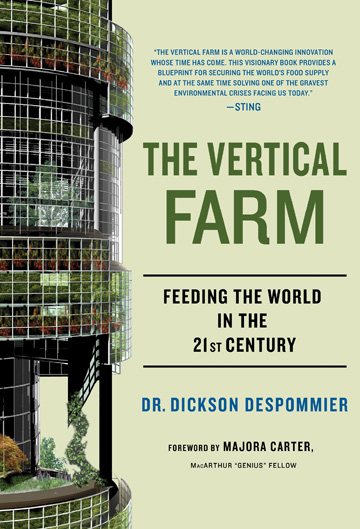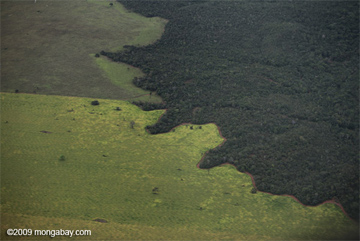To solve today’s environmental crises—climate change, deforestation, mass extinction, and marine degradation—while feeding a growing population (on its way to 9 billion) will require not only thinking outside the box, but a “new box altogether” according to Dr. Dickson Despommier, author of the new book, The Vertical Farm. Exciting policy-makers and environmentalists, Despommier’s bold idea for skyscrapers devoted to agriculture is certainly thinking outside the box.
Given the many environmental issues related to farming—as well as the threat climate change poses to agricultural productivity—Despommier envisions small skyscrapers that would produce fresh organic food for growing urban populations, while relieving natural landscapes of the pressure of agriculture. Theoretically this could lessen deforestation and perhaps even let some farmland return to the wild, thereby sequestering additional carbon. The concept, if successful, would be a win-win scenario: saving forests and species, mitigating agricultural pollution, while bringing fresh foods directly—with no transportation costs—to where most of the world’s people live, the city.
 |
In his new book, released today, Despommier has outlined in the idea of farms in the sky in great detail: highlighting the many benefits as well as discussing the obstacles.
Mongabay.com recently caught up with Despommier to discuss the potential of vertical farms and his new book. The book is now available on Amazon both as hardcover and for the Kindle.
INTERVIEW WITH DICKSON DESPOMMIER
Mongabay: What is your background?
Dickson Despommier: Microbiology and public health.
Mongabay: What do you see as the problems surrounding current agricultural practices?
Dickson Despommier: Climate change. Soil erosion. For every one degree increase in atmospheric temperature, there is an estimated 10% loss of agricultural land.
VERTICAL FARMS
Mongabay: How did you first hit on the idea of farms in skyscrapers, i.e. vertical farms?
Dickson Despommier: In a class I taught called Medical Ecology. The student s worked on roof top gardening without success and I said then why don’t we move the whole thing in doors inside abandoned apartment houses?
Mongabay: What made you to decide to turn this idea into a book?
Dickson Despommier: It was a natural progression from the classroom to the computer to keep track of all the urban agricultural initiatives. The book just sort of fell out by itself!
Mongabay: What would be the biggest benefits of this urban large-scale farming idea?
Dickson Despommier: Saving farmland for a return to nature!
Mongabay: How would such a farm benefit urban dwellers?
 Author of The Vertical Farm, Dickson Despommier. Photo by: Marlene Bloom. |
Dickson Despommier: Fresh produce 24/7!
Mongabay: How could vertical farms help save forests and biodiversity while fighting climate change?
Dickson Despommier: Again, returning land to forest instead of farmland is our best bet to sequester carbon from the atmosphere.
ISSUES
Mongabay: Your idea has not been without its critics. Recently George Monbiot wrote scathingly of the vertical farms idea in The Guardian, calling it “towering lunacy” due to problems with economics, disease, and energy requirements. How do you respond?
Dickson Despommier: We are all entitled to our opinions. There are those who derive a perverse sort of pleasure at poking fun at new ideas. I love proving them wrong! I have spent most of my life inside a laboratory, so I know what I am talking about when it comes to critics and their attitudes. Without constructive criticism, there is no criticism at all.
Mongabay: What do you see as the largest obstacles to this idea?
Dickson Despommier: Funding a prototype.
Mongabay: There have been a lot of success with rooftop gardens, but those are already granted free light from the sun. What source or sources would provide adequate light to grow plants on 30 floors of a skyscraper?
Dickson Despommier: Who said anything about a 30 story vertical farm?? I do not imagine this sort of thing at all. However, most of the supporters of the idea do. A small 5 story prototype is needed before we scale up.
Mongabay: How could such a farm be economically feasible, especially considering property rates in urban areas and the cost of building (or buying) a skyscraper?
Dickson Despommier: Until we have done the science, I cannot answer your question.
Mongabay: Do you see this idea as something that should be pursued by governments or the private industry?
Dickson Despommier: Yes, by both in partnership.
Mongabay: You’ve argued that such farms would not need to be powered with fossil-fuels, how is this possible?
Dickson Despommier: Capturing passive energy sources—wind, solar, tidal, geothermal.
IMPLEMENTATION
Mongabay: Are vertical farms being tried anywhere in the world today?
 The Amazon forest meets global agricultural demands in Brazil. A recent study found that 80% of tropical agricultural established from 1980-2000 came at the expense of forests. Photo by: Rhett A. Butler. |
Dickson Despommier: Yes, on the drawing boards all over the place!
Mongabay: How much money do you believe would be required to build one vertical farm in the US to serve as a model for how this idea could work?
Dickson Despommier: A 5 story prototype might cost any where from 20 to 30 million US.
Mongabay: Vertical farms is obviously a ‘thinking outside of the box’ idea. Do you think we need more concepts like this to tackle the world’s numerous environmental crises?
Dickson Despommier: No question. We need a new “box”!
Related articles
80% of tropical agricultural expansion between 1980-2000 came at expense of forests

(09/02/2010) More than 80 percent of agricultural expansion in the tropics between 1980 and 2000 came at the expense of forests, reports research published last week in the early online edition of the Proceedings of the National Academy of Sciences (PNAS). The study, based on analysis satellite images collected by the United Nations Food and Agricultural Organization (FAO) and led by Holly Gibbs of Stanford University, found that 55 percent of new agricultural land came at the expense of intact forests, while 28 percent came from disturbed forests. Another six percent came from shrub lands.
Nearly half of the world’s wetlands used for crops
(09/27/2010) Wetlands used for crops have expanded significantly over the past eighty years. According to a new study in the open-access journal Tropical Conservation Science, wetlands being utilized for crop production has jumped from 25 percent in 1926 to 43 percent in 2006 of the world’s wetlands as identified by the Ramsar Convention on Wetlands.
UN warns food prices could rise by 40 percent
(06/17/2010) Some staple food prices could rise by as much as 40 percent in the next decade, according to a new report by the UN’s Food and Agriculture Organization (FAO).